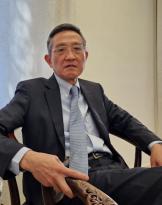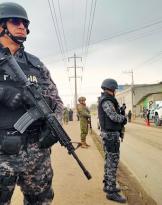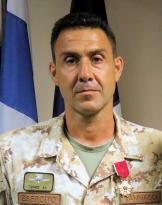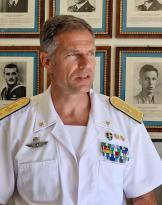How do you evaluate a soldier? It can be answered in many ways: from temper, intelligence, friends (and enemies ...), decorations on the chest, career, courage and even sympathy or antipathy; everyone has their favorite parameter and - as a human being - can also make mistakes freely.
Can we therefore judge the (military) leader of our Armed Forces? In this case the answer is only one: "in due time".
There are servants of the country who after a few years forget, others who regret, some who still hate each other. The feeling tends to be rather homogeneous because it is the effects of their actions that define them, a sort of "karma" (which, however, are paid for by others!).
The work of CHOD (Chief of defense) Vecciarelli in recent years has been demanding and "surprising". Although not a "proverbial communicator", he managed to denounce the political critical issues of the Defense that cannot be postponed, he allowed the first steps in the diffusion of a less improbable "military culture", and finally supported the reorganization of commands and structures that were previously not very operational, uncoordinated or even ineffective.
The task, if we think of the vastness and the "extraordinary" commitments of the military apparatus, is much broader and more complex. And the results - I repeat myself - will only be appreciated and assessed over time.
At the moment, however, it is our duty to try to understand the status of the "work in progress".
General Vecciarelli, has recently launched several warnings on the inadequacy of the military instrument to the new challenges and threats. What are the ways and strategies to solve the gaps?
In the context of the most authoritative institutional fora, I recently had the opportunity to speak about the "state of health" of the Italian Armed Forces. However, I was not referring to a mere statistical analysis; vice versa, I intended to focus on the ability of the military instrument to carry out the institutional missions for which it exists which, in the final analysis, means contributing to the security of the country and protecting its strategic interests. I therefore considered it appropriate to launch an in-depth study, launching the so-called Joint Joint Force General Planning. A process oriented on two fundamental guidelines which, beyond the technicalities, on the one hand guaranteed the maintenance of the operational capabilities of the systems already in use, still capable of generating an operationally significant effect, and on the other, the renewal, strengthening and in some cases the acquisition of essential skills, especially looking to the future.

I am referring to a path of modernization aimed at pursuing an even more marked and profound interoperability between the components, but also the development of capacity in the space, cybernetic and digital domains, by their nature transversal, pervasive and with wide margins for innovation and growth. It goes without saying, however, that such a path, the widespread instability and fragmentation of the reference landscape and the complexity of the scenarios in which we will operate, make it essential to develop adequate decision-making skills, supported by an effective information framework: enabling elements and, at the at the same time, growth factors of a modern defense system.
As mentioned, all systems must be fully integrated with each other and with the information and command systems, thus seeing the overall effect generated multiplied.
The in-depth and detailed analysis carried out also allowed us to identify critical issues and opportunities, which have become priorities where we can operate with greater financial and programmatic incisiveness, in order to generate concrete effects both in relation to our ability to defend the state and national strategic interests, and to fulfill the commitments that the country has assumed within the Alliances, NATO and EU in the first place, in a scenario, I remember, complex, competitive and fragmented.
Finally, it goes without saying that from a geostrategic point of view, our attention has turned primarily (but not exclusively) to the so-called enlarged Mediterranean, understood as a real multi-domain “system”. All this, with the awareness that investment in defense is also an important driver of growth for the country system, which will benefit from it in terms of credibility, competitiveness, stability and economic and technological development.
After the conflict in Artsakh it is clear that antidrone systems no longer have to neutralize "toys" flying over a barracks. What are you doing about it?
The use and use of remotely piloted systems (UAV), especially of the Mini and Micro class, is spreading with great speed and with ever more advanced capabilities and functions. Their alternative use for criminal or terrorist purposes is indeed a real risk. The detection, identification and neutralization of systems flying in the vicinity of infrastructures and sensitive areas is therefore a skill of fundamental importance. Since the characteristics of these systems often allow to evade both the defensive point installations and the detection systems of the National Air Defense, it was necessary to develop dedicated devices and ad hoc procedures. With this in mind, we first tried to capitalize on new technological developments by seeking integrated command and control (C2) solutions based on increasingly advanced IT capabilities.
 The Defense has therefore launched ambitious development initiatives in the sector, aimed at implementing state-of-the-art solutions, capable of operating in an integrated way in the broader National Air Defense architecture and at the same time guaranteeing the protection of forces and areas and objectives. sensitive. In this perspective, we have created two federated Centers of Excellence, that of Amendola, of general value and that of Sabaudia, more specific for the mini - micro part, we have already equipped ourselves with some state-of-the-art systems and we are actively supporting the development of innovative solutions, in synergy with the national industry.
The Defense has therefore launched ambitious development initiatives in the sector, aimed at implementing state-of-the-art solutions, capable of operating in an integrated way in the broader National Air Defense architecture and at the same time guaranteeing the protection of forces and areas and objectives. sensitive. In this perspective, we have created two federated Centers of Excellence, that of Amendola, of general value and that of Sabaudia, more specific for the mini - micro part, we have already equipped ourselves with some state-of-the-art systems and we are actively supporting the development of innovative solutions, in synergy with the national industry.
There are serious shortages of ammunition on the one hand and of capacity (eg. land attack navali) on the other. He raised an alarm. Results?
The use of the military instrument in a highly competitive scenario, in which we are confronted with an enemy of similar capabilities to ours, unfortunately now also in the availability of non-state actors, postulates the availability of armament and ammunition, to a greater extent than it is currently available in our warehouses and arsenals.
It is a national need and, at the same time, part of our commitment in NATO, for collective defense. Ammunition, however, as you know, expires and technologically more complex armaments require periodic updates. In this sense, I have already recently arranged for the financing of an ammunition procurement program of various calibers for all components, as well as the development of modern weapon systems that can increase the effectiveness of the available systems. Having modern wagons, ships, airplanes and not being able to guarantee their full functionality due to lack of ammunition, would in fact risk making the efforts made in vain.
For this it was necessary to focus attention on this area and allocate resources consistent with our commitments and our role.
Just to cite a few examples, in the near future we will have the Volcano, both in the land and naval version, of the Teseo, in its modernized and more performing version, of the New Heavy Torpedo and we will integrate the aerotactic lines with new armaments (from launch and guided fall ).
Why do we allow ourselves the luxury of updating outdated systems like the Aries wagon?
One of the tasks of the head of the SMD is to ensure that the Military Instrument is integrated, balanced, relevant and, above all, capable of achieving the effects necessary to protect the security of the country.

The heavy component, as you know, is one of the “core capabilities” through which first of all, deterrence and, possibly, response capacity are ensured. In this sense, for protection, mobility and engagement, it is an indispensable capacity both in the operational contexts of Collective Defense and in the context of Crisis Response Operations, characterized by the risk of sudden increases in the threat.
NATO itself, in the context of recent policy documents (such as the Political Guidance 2019), recalls its importance, in terms of availability and efficiency, hoping, in light of the renewed emphasis assumed by the "Collective Defense", a strengthening already starting in 2024.
For these reasons, there is an urgent need to ensure a level of efficiency at least sufficient, for a period of ten years, by optimizing the financial effort. In other words, it is a question of satisfying the need to continue to generate an effect in this capacitive segment, in operational and training terms, by modernizing the platform already present in our Tank Departments, however already looking to the future, to equip the Defense with a new tank. generation, which intercepts the most advanced technological solutions available and represents the pillar of the component in the long term. An ambitious program, which will see the national industry as a protagonist, but which embraces a necessarily long period of time, which therefore requires a mitigating solution such as the one proposed.
Armed drones? Minister Pinotti already 5 years ago was a possibility ... And with the cut of the F35 we will suffer even more in the compensation of entire flight lines. Will we acquire them?
The APR with kinetic capability - already used by other NATO countries - are certainly of interest to us and find a solid rationale for use within the broader Defense strategy aimed at improving the protection and support capabilities of the ground forces, as well as the engagement of objectives, even in non-permissive environments - the so-called Joint Precision Strike - without however compromising the principles of the DIU (necessity and proportionality) and the national legal framework.
Italy is among the leading nations in the use of RPAs, with which it has been successfully operating for over 15 years in all the main operating theaters; the objective is therefore to make this capacity evolve by exploiting its peculiar characteristics (accuracy of the sensors, prolonged stationing on the area of operations, flexibility of use with the possibility of reorienting the mission in the tactical phase, real-time connection with the decision-making chain ) to have the ability to engage targets, including opportunities, as well as to intervene in defense of personnel operating in the area of interest, in an effective, timely and precise manner it's safe.

From an operational point of view, on the other hand, UAVs are aircraft in all respects and their use does not differ much from that of "traditional" piloted aircraft, except for the remote control aspect, which however is responsibility of fully qualified and trained personnel.
Drones on board: after the USA even Turkey is planning them. Italy?
Modern air and naval operations embrace a wide spectrum of missions, from the more traditional ones (projection of military capabilities), to constabulary tasks (anti-piracy, countering terrorist activities, checking the legitimacy of maritime traffic), to humanitarian relief or support initiatives. to the civilian population. This scenario requires the availability of a robust, comprehensive, timely and organic flow of information to the Naval Force in order to achieve an adequate level of Situational Awareness and exercise effective Command and Control (C2) of operations, which is also integrated in a multi - domain perspective.
A significant part of the information contribution to these operations derives from the use of embarked aircraft which, by virtue of the intrinsic characteristics that distinguish them, represent ideal platforms for conducting Intelligence, Surveillance & Reconnaissance (ISR) activities. In this regard, the Defense has been working for some time in this segment and evaluating development initiatives to equip us with an embarked APR capacity, to enhance the information collection and surveillance activities of the Naval Units, to guarantee a more effective capacity for identification, selection, discrimination of objectives and, at the same time, ensure adequate protection for the Units.
How many international missions are really fundamental to the national interest? Which ones will we conclude shortly?
We are today in a completely transformed global context. The pandemic has given a strong acceleration to competitive dynamics with state and non-state actors, in search of new positions also in areas of our traditional competence, using cutting-edge systems and technologies, often in conflicts of "variable intensity", not far from the our territory.
What is worrying, in addition to the stability of the delicate and unstable geopolitical balances, are the possible long-term criticalities, even indirect ones: economic divergence, social imbalances, vulnerability of the most fragile states, market volatility, all elements that are constantly analyzed in the context of Staff in its entirety.

In this challenging scenario, the Armed Forces stand in defense of the country and its institutions, with a convinced and unchanged sense of the state, a spirit of service and unity of purpose. This unified vision made it possible to develop a harmonious plan of international relations, having clear areas of national interest, according to the guidelines of the Minister of Defense.
In particular, missions and operations abroad, a central element of the Defense and Security policy, assume political and strategic importance to guarantee the protection of our priority interests. Italy, by its traditional vocation, hopes that its military interventions fall within the broader framework of the initiatives promoted by the International Organizations to which it belongs (UN, NATO, EU) and uses its own military instrument in harmony with international mandates.
The current geostrategic framework does not therefore seem to allow, at least in the short term, a decrease in commitment. On the contrary, we are fully aware that the National Military Instrument will have to face a growing effort - also taking into account the projection of the effects deriving from the COVID-19 pandemic - primarily in the Euro-Mediterranean Region and in the contiguous areas, without neglecting the most distant areas: Balkans , Maghreb (with specific reference to Libya) and Sahel, Horn of Africa, Gulf of Guinea, in addition to the Middle East and the Arabian Peninsula.
This, in synergy with the Alliances and Coalition Countries to which we adhere, will allow us to focus the attention of the Military Instrument in the priority areas for us. If we look at Iraq, for example, the Coalition (Operation Inherent Resolve) is progressively passing the baton to NATO. In Iraq, we believe that the national military presence is essential for the reconstruction and resilience of local security forces. Our commitment will be assured and we are ready to shift our capabilities from OIR (the Coalition) to NMI (NATO). In perspective, the NATO Mission in Iraq could become an alternative model in which Italy can play an important role, maintaining the role of privileged interlocutor of the Middle Eastern country.
Similarly, in Afghanistan, as is known, following the US - Taliban agreements of 29 February, the NATO Operation of Train Advise Assist "Resolute Support" is decreasing its numerical consistency and, where conditions permit and the decision policy will be taken, the progressive closure of the regional commands will be initiated. Clearly Italy is ready to model its own in line with NATO's plans. Beyond the single operation, however, I would like to draw attention to the interconnection that characterizes them and the overall effect they generate, in terms of stability and security. That's what we're aiming for.
 The F-35Bs have limitations and defects unknown to version A and will be insufficient to equip Italian naval units. Does AM have to have them at any cost?
The F-35Bs have limitations and defects unknown to version A and will be insufficient to equip Italian naval units. Does AM have to have them at any cost?
The F-35B, Short Take-Off and Vertical Landing (STOVL), version with short take-off and vertical landing, largely allows the carrying out of the same types of missions as the F-35A version, combining multirole capabilities of absolute excellence, characteristics advanced stealth, high integration of the various onboard sensors, detection capabilities, identification and engagement accuracy, communications suite with net-centric capabilities and innovative support logistics, which allow the system to express unique multi-mission capabilities, both in scenarios air-air than air surface. Furthermore, the STOVL version allows use both on LHA / LHD / CV (Amphibious Assault Ships and Aircraft Carrier) type Naval Units, and on short or semi-prepared runways.
The decision to equip the AM with F-35B aircraft was born in the early 2000s due to an operational need that is still current, which is also reflected in other countries (United Kingdom, Japan and Singapore) due to mobility and flexibility. operating system of the F-35B system, able to guarantee the reduction of the logistic footprint and flexibility of redeployment on advanced operational bases, increasing the capacity and the possibility of immediate response of the aerotactic component. This capability is a key enabler for land and sea forces in support of any surface operation. Furthermore.
The timing established by the current delivery profile of the F-35Bs for Italy, although not optimal due to the cuts in the past, will still allow the achievement of a credible national aircraft carrier capability, allowing a significant generational leap compared to the AV-8B aircraft. , in harmony with the consolidated intentions and priorities of the political and military Summits of Defense; the consequent machine assignment program is therefore functional to guarantee an adequate and balanced distribution of the assets, in view of the achievement of an initial “sea based” and “land based” operational capacity.
Is it serious to still discuss the F-35 when one should exclusively dedicate oneself, like other countries, to the next two generations or operational theaters such as space and cyber-security?
In reality, no major country has adopted a similar strategy. If it is in fact true that we are registering a growing attention towards space and cyber, this does not happen to the detriment of the most modern weapon systems of the traditional segment (only apparently).
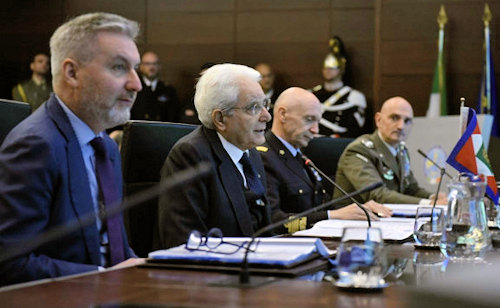 When we talk about F-35 we are talking about a system of systems, particularly advanced, which confers a competitive advantage also in the information field and in the management of the multi-domain C2. What I see is integration, multiplication of effects, with emergent domains, not capacitive antithesis.
When we talk about F-35 we are talking about a system of systems, particularly advanced, which confers a competitive advantage also in the information field and in the management of the multi-domain C2. What I see is integration, multiplication of effects, with emergent domains, not capacitive antithesis.
I also find it difficult to think of being able to develop (or participate in development) even more advanced systems, without having developed the skills and knowledge that only participation in programs of such complexity and sophistication can give. With this in mind, we too are paying great attention to capacitive development in the space and cyber sectors, in synergy with institutional, industrial, academic and research realities.
Technological development and the so-called “disruptive technologies” are at the same time an opportunity to be exploited and a threat to be mitigated and, in this perspective, the Italian Armed Forces will not lose the opportunities offered by the new enabling domains.
Photo: Ministry of Defense / Chamber of Deputies / Italian Army / US DoD / Air Force / Navy



